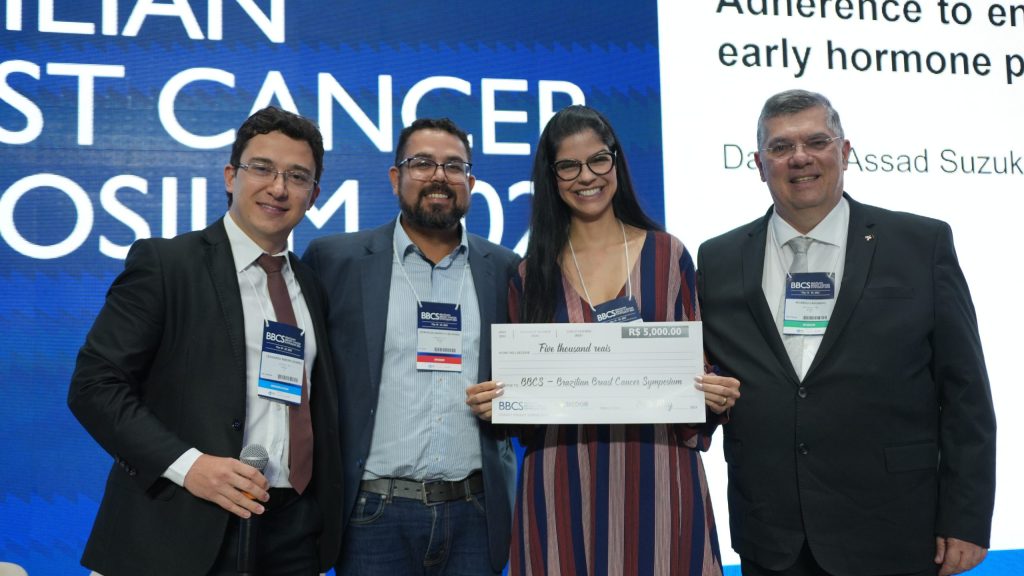
EXTERNAL PROSTHESES AFTER MASTECTOMY: ADHESION, MANUFACTURE AND SELECTION OF A LOW-COST FUNCTIONAL MODEL TO BE PERFORMED IN DEVELOPING COUNTRIES
René Aloisio da Costa Vieira1,2,3,4; Matheus Sampaio Ibrahim4; Lucas Guimarães de Souza Araujo4; José de Assis e Souza Junior3; Luiz Carlos Navarro de Oliveira3; Carla Simone Moreira de Freitas3
1Postgraduate Program in Tocogynecology. Botucatu Faculty of Medicine, Brazil.
2Postgraduate Program in Oncology. Barretos Cancer Hospital, Brazil.
3Muriaé Cancer Hospital, Brazil.
4Faculty of Medicine at UniFaminas/ Muriaé, Brazil.
Objective: Objective: Create a low-cost external breast prosthesis (BEP) and evaluate factors associated with non-adherence BEP use. Methodology: Methodology: Study approved by Brazilian Ethics Committee CAAE 68799223.2.0000.5105. A observational, prospective transversal study, carried out in a Tertiary Public Oncological Hospital, in previously mastectomized patients, without breast reconstruction, aiming to evaluate factors associated with non-adherence to BEP. In addition to this fact, we create a low-cost PME, lightweight and with low purchase cost. The patients were presented to 5 prosthesis models, one commercial, three manufactured models and the new model. They had different weight, covering and filling material. The patients chose two prothesis justifying it. In assessing adherence or non-adherence to the use of the prosthesis, the chi-square test and logistic regression were used. Results: Results: The silicone prosthesis cost was US$40, with weight ranging for 123 to 504 grams, and the new BEP cost was US$4, with weight ranging 19 to 48 grams. When asked to select two prosthesis options, it was observed that the first choice was the silicone prosthesis (33.9%), and the second option was the prosthesis made in the study (70.5%). Of the 72 patients evaluated, 45.8% (33) did not use BEP. Excluding patients with a follow-up period of less than 1 month (n=9), failure to use BEP was associated with lack of knowledge (n=9), poor adaptation (n=4), with the remainder having no reason (n= 8). Evaluating the factors time since surgery, age, education, prosthesis size, clinical stage, BMI; age and BMI were associated with not using BEP. The factors that patients consider most important in a prosthesis were weight (41.7%), shape (29.2%), comfort (15.3%), ease of cleaning (12.5%). Conclusion: Conclusion: There are multiple barriers related to non-adherence to BEP, making it necessary to improve patient knowledge and adherence. The new BEP is lightweight with low cost production, facilitating its production and patient adherence in low-income countries.
Keywords: breast neoplasms; external breast prosthesis; quality of life

ADHERENCE TO ENDOCRINE ADJUVANT THERAPY IN WOMEN WITH EARLY HORMONE POSITIVE BREAST CANCER
Daniele Assad Suzuki¹, Danielle Laperche dos Santos², Anna Luiza Galvão³, Sulene Cunha Souza Oliveira4, Cristiano de Pádua Souza5, Amanda Guimarães Castro Custódio¹, Romualdo Barroso-Sousa6
¹ Hospital Sírio Libanês|Brasília|Distrito Federal|Brazil
² Hemolabor|Goiânia|Goiás|Brazil
³ UniCeub|Brasília|Distrito Federal|Brazil
4 Liga de Câncer de Natal|Natal|Rio Grande do Norte|Brazil
5 Hospital de Amor|Barretos|São Paulo|Brazil
6 Hospital Brasília, DASA Oncologia|Brasília|Distrito Federal|Brazil
Objective: This study aims to evaluate adherence to adjuvant endocrine therapy in woman with early breast cancer and explore its relationships with patients’ clinical and social characteristics and site of treatment. Methodology: Women with a past history of early-stage estrogen-receptor positive invasive carcinoma of the breast on adjuvant endocrine therapy for at least 6 months were invited to participate of this study. Adherence was assessed with questionnaire MMAS-8. Demographic and clinical information were reviewed from medical records. Data collection performed using RedCap software and statistical analyzes were performed on the software R (R Core Team (2022). Results: From June 2021 to March 2023, a total of 212 patients were recruited in 6 institutions. Median age was 56 years. 29,2% were black. 24,1% were premenopause. 38,2% had stage I disease. 65,1% received chemotherapy. 16,5% received HER2 blockade. Mean duration of endocrine therapy use was 3,7 years. 115 patients (54,2%) used aromatase inhibitors. 24 patients (11,4%) had low adherence, 76 (365) had intermediate and 111 (52,6%) had high adherence to adjuvant endocrine therapy. There is a tendence that more postmenopausal women were classified in high adherence grupo than premenopausal women (55.9% vs 42% p=0,19). There is a tendence that more woman in public service had high adherence than woman in private service (59.3% vs 50.3% p=0.07). There was no difference in adherence in relation to ethinicity, type/duration of endocrine treatment. Conclusion: This study for the first time show that high adherence to endocrine therapy only happens in 52.6% of patients, lower than reported in previous studies. This result draws attention because it can compromise survival. We will continue the recruitment of patients in the private service and in the public service to assess the rate of adherence in a larger population and the relationship with demographic characteristics.
Keywords: Hormone Therapy; Breast Cancer; Medication Adherence